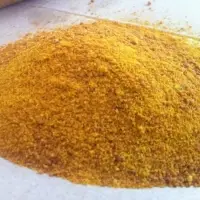

Popcorn Botanical name Zea mays everata Sturt Taste Typical Odor Odourless, no foreign odours Color Typical, yellow/orange – typical Production area Expansion 38/40, 40/42, 42/44, 44/46, 46/48, Mushroom Packing Paper bags 20kg and 50lb and polypaper bags 20kg and 50lb Loading 20 feet: 25.5 metric tonnes with 20/25kg bags or 24 metric tonnes loading ANALYSIS VALUES Purity 99.5% min Foreign bodies 0.50% max Explosion 98% min Moisture 15.0% max / 12.0 % min Broken/Damaged 1.00% max Insect damage 1.00% max Discolored 0.30% max Undersize 5mm 2.50% max Live insects Free Total Defects 3.5-4.5% max (Deppending on expansión)
Corn gluten meal is a yellow powder or granular created as a by-product during a milling process corn. It is a high-protein concentrate typically supplied at 60% protein. It is a valuable source of methionine. It is primarily used as a supplement in farm animal feeds, dog food, and fish food. Corn gluten meal also has a level of xanthophylls, which offers the poultry feed formulators an efficient yellow pigmenting ingredient. Corn gluten meal also is excellent cattle feed providing a high level of rumen bypass protein. Specification Protein 60% min. Ash 3% max. Moisture 12%max. Fat 5%max. Fibre 2% max.
Corn gluten meal is a yellow powder or granular created as a by-product during a milling process corn. It is a high-protein concentrate typically supplied at 60% protein. It is a valuable source of methionine. It is primarily used as a supplement in farm animal feeds, dog food, and fish food. Corn gluten meal also has a level of xanthophylls, which offers the poultry feed formulators an efficient yellow pigmenting ingredient. Corn gluten meal also is excellent cattle feed providing a high level of rumen bypass protein. Specification Protein 60% min. Ash 3% max. Moisture 12%max. Fat 5%max. Fibre 2% max.
Yellow Corn NON GMO - Specification/ Quality Type NON GMO Yellow Com Fit tor Human Consumption Origin Crop: Brazil Crop: Brazil 2020/2021 Protein Level 9%min Fat Moisture Content 14%maximum Fiber 3,3% min Hectolitre 67KC min Ash Content 1,5% maximum Aflatoxin Damaged Grains: 20PPB maximum Otner Cereal Grains 2% maximum Toxic Grains: 2-3 per 100 G maximum GMO Yellow Corn (Brazil) Non GMO / GMO (USA) Available
Whole kernels - 60 % Head rice,Brokens - 5 % Small brokens - 7 % Small brokens (cl)- 0.10 % Long grain class 1 - 20 % Long grain class 2 and class 3 -70 % Short grain - 10 % Red and undemilled kernels - 2 % Yellow kernels - 0.5 % Chalky Kernels - 6 % Damaged Kernels - 0.25 % Undeveloped kernels/ immature kernels /Foreign matter and other seeds - 0.3 % Glutinous rice - 1.5 % Paddy grains ( 1 kg) - 10 % Moisture - 14 % Milling degree - Well Milled
Whole kernels - 60 % Head rice,Brokens - 5 % Small brokens - 7 % Small brokens (cl)- 0.10 % Long grain class 1 - 20 % Long grain class 2 and class 3 - 70 % Short grain 10 % Red and undemilled kernels 2 % Yellow kernels 0.5 % Chalky Kernels 6 % Damaged Kernels 0.25 % Undeveloped kernels/ immatured kernels /Foreign matter and other seeds 0.3 % Glutinous rice 1.5 % Paddy grains ( 1 kg) 10 % Moisture 14 % Milling degree Well Milled
Yellow corn, also known as maize, is a widely cultivated cereal grain celebrated for its vibrant yellow kernels and versatile culinary applications. It is a staple food in many parts of the world, known for its sweet and slightly nutty flavor. Yellow corn is used in a variety of forms, including fresh corn on the cob, canned corn kernels, cornmeal, and corn flour. It serves as a key ingredient in a multitude of dishes such as tortillas, polenta, cornbread, and as a side vegetable. Beyond its culinary uses, yellow corn is also a valuable source of essential nutrients like carbohydrates, fiber, vitamins, and minerals, contributing to its significance as a food staple and livestock feed.
Among the characteristics of the purple corn that is most known and obvious is the purple color, and this color is given by the amount of anthocyanins, this type of pigment is what makes this fruit have antioxidant properties of great value in human health. 100% organic Rich in antioxidants Protect against atherosclerosis Lowers blood pressure Elevates antioxidant capacity of the blood Obesity and diabetes preventative and cure






